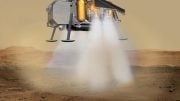
Mars Sample Return is a mission to return Martian samples collected by the Mars Perseverance rover to Earth. Credit: NASA/ESA/JPL-Caltech/GSFC/MSFC
NASA and the European Space Agency are developing plans for one of the most ambitious campaigns ever attempted in space: bringing the first samples of Mars material safely back to Earth for detailed study. The diverse set of scientifically curated samples now being collected by NASA’s Mars Perseverance rover could help scientists answer the question of whether ancient life ever arose on the Red Planet.
Bringing samples of Mars to Earth for future study would happen in several steps with multiple spacecraft, and in some ways, in a synchronized manner. This short animation features key moments of the Mars Sample Return campaign: from landing on Mars and securing the sample tubes to launching them off the surface and ferrying them back to Earth.
Animation is contributed by NASA’s Jet Propulsion Laboratory, the European Space Agency, Goddard Space Flight Center, and Marshall Space Flight Center.
This short animation features key moments of NASA and ESA’s Mars Sample Return campaign, from landing on Mars and securing the sample tubes to launching them off the surface and ferrying them back to Earth. Credit: NASA/ESA/JPL-Caltech/GSFC/MSFC
NASA and the European Space Agency (ESA) are planning ways to bring the first samples of Mars material back to Earth for detailed study. The Mars Perseverance rover is the first leg of this international interplanetary relay team. Its job is to collect and cache samples on Mars.
A Sample Return Lander would land near or in Jezero Crater, bringing a small rocket on which the samples collected by Perseverance would be loaded. Two Ingenuity-like helicopters would provide a secondary capability to retrieve samples on the surface of Mars.
Once the sample cache is launched off the Red Planet, another spacecraft would capture it in Mars orbit, and then bring it back to Earth safely and securely in the early to mid-2030s.
These first collected and returned samples could answer a key question: did life ever exist on Mars? Only by bringing the samples back can we truly answer the question by using the most sophisticated, state-of-the-art labs, at a time when future generations can study them using techniques yet to be invented.









Still milking the Mars cow I see. Why? Why are you doing this. Persi has everything you need to research any sample from Mars. Again, Why are you wasting money on this? Your criminally malfeasant. You all need to be fired.
Going back to pick up billion year old rocks that have not been studied by the rover who selected them makes no sense. Some of the rocks are not even sediments that would be required to look for evidence of life. A great technological feat, but little little else.
it doesnt tell me anything so take a L